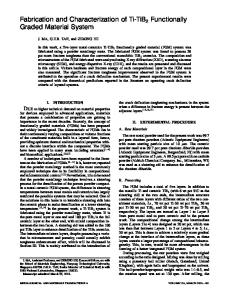Fabrication and properties of functionally graded NiAl/Al 2 O 3 composites
- PDF / 1,232,106 Bytes
- 10 Pages / 576 x 792 pts Page_size
- 6 Downloads / 381 Views
R. D. Noebe NASA-Lewis Research Center, 21000 Brookpark Road, Cleveland, Ohio 44135-3191 (Received 29 December 1992; accepted 15 April 1993)
A modified sedimentation process was used in the production of a functionally gradient material (FGM), NiAl/Al 2 O 3 . A simple finite element model was used to guide our design and fabrication efforts by estimating residual stress states as a function of composite structure. This approach could lead to tailored designs that enhance or avoid specific residual stress states. Thermal cycling tests were factored into the model to predict time dependent or steady-state internal temperature and stress profiles. Four-point bend tests were conducted to establish the mechanical load-displacement behavior of a single interlayer FGM at room temperature, 800 and 1000 K. Room temperature bend strength of the FGM was 3 - 4 times that of the base NiAl. At elevated temperatures, composite fracture occurred in a gradual, noncatastrophic mode involving NiAl retardation of a succession of cracks originating in the alumina face.
I. INTRODUCTION Unlike conventional composites that are homogeneous on a macroscopic scale, functionally gradient materials (FGM's) are a class of composite materials that vary continuously in composition and microstructure along the thickness direction. Consequently, FGM's have the potential to meet a wide range of engineering applications since the compositional gradient can be tailored toward specific requirements. This versatility means that FGM's are not only of increasing interest in advanced engines and airframes, but in other potential applications such as armor, medical implants, and electric or dielectric devices.1 For all of their potential uses, FGM's are primarily in the evaluation stages; little is known about their actual properties or performance. This is due in part to a lack of clear direction in the design and processing of functionally gradient materials. The success and flexibility of our fabrication procedure, based on a modified sedimentation process, have allowed us to produce enough samples to measure the response of these materials to both mechanical and thermal stress. Initially, nebulous design guidelines have been formalized into a finite element model that successfully guided our fabrication efforts. This predictive tool was used in the design process to give qualitative a
'Address correspondence to this author.
2004
J. Mater. Res., Vol. 8, No. 8, Aug 1993
estimations of the residual stress states. Control of these states could lead to tailored FGM designs that enhance or avoid specific residual stress states. This residual stress information is also critical in understanding the mechanical behavior of these composites. Our approach to solving for these stress profiles relied on laminate and plate theory, in which the solutions were determined by minimization of strain energy.2 The parameters involved in thermal cycling tests at 1088 K were also incorporated into the model to allow prediction of time dependent or steady-state temperatu
Data Loading...











